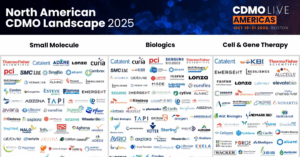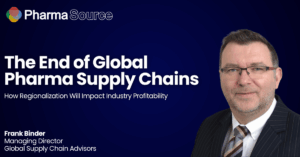“Life has not become simpler and easier. It’s become more complex. Success requires acknowledging this complexity early and building flexibility into every aspect of the business model.”
Renée Aguiar-Lucander is the CEO of Hansa Biopharma, appointed in April 2025. Renée brings rich expertise from seven years leading Calliditas Therapeutics through a dual NASDAQ listing and the first approved drug for IgA nephropathy, plus extensive healthcare investment experience at Omega Funds and 3i Group.
Speaking to PharmaSource at Nordic Life Science Days (NLSDays), Renée shares candid insights on the investment climate that’s reshaped biotech over the past few years, the structural challenges facing European companies, and what early-stage biotechs need to focus on to survive an increasingly selective funding environment.
Advice for Biotech Leaders
“Understand the unmet medical need, the market opportunity, and your unique value proposition—and stay focused on those fundamentals. At the end of the day, those priorities haven’t changed.”
Renée Aguiar-Lucander, CEO, Hansa Biopharma
Renée emphasizes validation of the fundamental value proposition. “Engage with key opinion leaders and patient groups to ensure your work truly addresses an unmet medical need,” she advises.
But addressing need alone isn’t sufficient. “Make sure your work goes beyond being just slightly better than existing solutions. Identify a true niche and a unique value proposition that can stand the test of time.”
Once the scientific foundation is solid, flexibility becomes critical. “You just have to take a very broad view on where might you get the funding and the support for this. Be willing to be agile, to shift, to swap, to do whatever’s necessary to move forward.”
The current environment demands this adaptability. “There are hand grenades being thrown here, there, and everywhere at the moment. It is very difficult to have a fixed route. You just have to be prepared for whatever might come your way and try to be as creative as you can to address those obstacles.”
She emphasizes the importance of relationship building beyond local markets. “Take a broad view, not just your own local market, but really try early on to establish relationships with relevant sources of capital or companies so that you can continue to educate yourself and validate that path you’re on as you go. If you need to change it because of new information, then you just have to be willing to do that.”
Leading Through Transition
Hansa Biopharma has a proprietary enzyme technology platform designed to address rare disease patient populations. The Swedish biotech’s approach centers on enzymatic modulation of antibodies, offering potential solutions where conventional therapies have limited efficacy. With multiple clinical programs targeting distinct rare disease indications, the company maintains a diversified pipeline built around its core technology platform.
When Renée joined as CEO in April 2025, her priorities focused on financial restructuring. “The focus was to address staffing levels, burn rate, and there was some debt in the company that needed restructuring. All of these things just needed to be done first as a key priority,” Renée explains.
The restructuring timeline was dictated by clinical milestones. One Phase III readout occurred in late September, with a second planned for Q4. The company needed financial stability to reach these catalysts and position itself to capitalize on positive results.
“The key priorities were to ensure that the company was able to comfortably get through those readouts and then raise capital on the back of that good news, which is what we just completed,” she says.
What drew her to Hansa was the technology’s fundamental differentiation. “The company’s technology platform is truly unique and innovative, and it’s clear that its pioneering position has been sustained over time.”
The Investor Lens
“It’s helpful to put yourself in the shoes of your shareholders and really try to understand how they look at the business, what risks they perceive, and how they really feel about not just catalysts but also the medium and long-term funding outlook,” she explains.
This understanding proves particularly valuable in biotech, which is “by definition a very high capital use industry.” Familiarity with various capital sources and negotiation dynamics with financing counterparts has been “incredibly helpful” in navigating Hansa’s turnaround.
The investor perspective shapes strategic decisions about burn rate, milestone planning, and capital deployment in ways that purely scientific or operational backgrounds might miss.
Four Years of Capital Constraints
The biotech funding environment has transformed dramatically over the past few years, creating challenges that persist today.
“It’s no news to anyone that over the last four years or so, it’s been a really challenging time for biotech in terms of the funding environment,” Renée notes. “There was a period of time prior to that when money was almost growing on trees. The last four years have been the absolute opposite.”
Two factors drove this shift.
- Rising interest rates
“Because early-stage biotechs are not revenue-generating or profitable, they are all dependent on Net Present Value (NPV) calculations,” Renée explains. “If you increase your discount rate significantly in those NPV calculations, the number you end up with tends to be a lot smaller.”
This dynamic particularly affects companies that are several years from revenue, making later-stage assets more attractive to capital.
- Capital deployment
“There had been so much capital deployed in the biotech and life sciences industry where it was clear that a lot of that capital, unfortunately, was probably not going to be able to give a return in the near and medium term.”
This has forced biotechs to become creative about financing sources and more disciplined about capital efficiency.
Alternative Financing
Traditional equity financing alone can’t support most biotech development timelines, making alternative funding sources essential.
“You’ve got to get comfortable using different funding sources and finding creative ways to stretch your runway without always turning to the equity market,” Renée advises.
She points to several alternative paths companies should explore:
Government grants represent a critical non-dilutive option that biotechs often underutilize. These require upfront investment in application processes but can meaningfully extend runway.
Strategic partnerships allow companies to share development costs and risks. “That’s one way that you can extend your runway further without having to go to the equity market,” she notes.
Out-licensing opportunities in different geographies can provide capital while maintaining core value. This is “something that companies perhaps didn’t have to think about before when there was lots of capital available.”
The key is starting these conversations early. “You really need to start building those relationships quite early on,” Renée emphasizes. “Really, as early as possible, even though you may not think that you need them for another two, three years. It’s still worthwhile to engage with people and educate them about what you’re doing, having those discussions.”
The China Challenge
Looking ahead, Renée identifies China as perhaps the most significant factor that will reshape the competitive landscape for European biotechs.
“China is already a real contender out there in life sciences,” she observes. “You’re seeing more and more people really putting people on the ground in China to understand that market better.”
For European companies already operating with less capital access than US competitors, China represents an additional challenge. “The rise of China is going to pose a real challenge to US and European biotech companies,” Renée says.
However, she sees a potential opportunity in this shift. “Europeans are already used to trying to do things cheaper and faster because we don’t have some of the access that US companies have to capital. I don’t think we are going to have to change our model.”
The opportunity lies in in-licensing and technology transfer. “Maybe European companies can start in-licensing and using some of that technology, making Europe more competitive rather than less. We just have to see it as an opportunity.”
She acknowledges the complexity: “It’s a complex opportunity and it just means we have to spend even more time trying to figure things out early on.”
This also affects market targeting decisions. With challenging European pricing regulations, “bringing products to market in Europe may become more and more difficult. Biotech companies based in Europe have to think about which market they’re actually going to try to target in terms of what patient population. It’s always been the US, but maybe that’ll shift to some other markets in Asia.”
Why Europe Needs Integrated Capital Markets
When asked about what would truly transform the European funding landscape, Renée identifies one structural change that would be genuinely transformational – though she’s pessimistic it will happen.
“The only thing that would truly reset the landscape and really change the funding environment in Europe would be to have integrated public capital markets,” she says. “I don’t think that’s ever going to happen.”
The current fragmentation creates fundamental disadvantages. “If we had one large exchange instead of 15 small country exchanges, that would probably be the biggest potential impact that would really be a huge change.”
The problem is nationalism in capital deployment. “It’s very nationalistic – you have small local funds that only invest in their own country. You don’t build that liquidity and depth of capital that you can have if everyone were quoted on the same exchange.”
Integration would create “that capital depth you find in the US. The US is one market, one exchange. Everybody plays in the same sandbox. It’s much easier to compare things and have a relative view on things.”
This structural advantage makes US biotech fundamentally more competitive. “That would by far be the biggest game changer for European investors,” Renée concludes. “But again, I don’t think that’s ever going to happen.”














